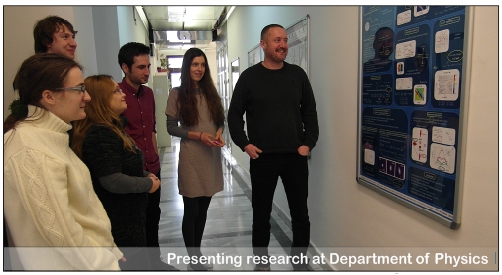O B A V I J E S T
LUKA PALADA
održat će znanstveni kolokvij (doktorski seminar) iz Nuklearne fizike pod naslovom
Structure of light atomic nuclei studied with nuclear reaction 14N + 10B
(Građa lakih atomskih jezgara proučavana nuklearnom reakcijom 14N + 10B)
In light nuclei both single-particle dynamics and nucleon correlations, which result in clustering, are well manifested. The correlations and formation of $\alpha$-clusters are closely related to fine details of the nuclear force as well as to spatial and quantum symmetries within the nuclei. Modern nuclear theories are able to model structure and trace the origin of $\alpha$-clustering in $A < 20$ nuclei from first principles, starting from individual nucleons. Calculated nuclear properties should be compared with experimental data and therefore high-precision experimental results on the key nuclei are of prime importance to benchmark these models.
Key nuclei to understand $\alpha$-clustering are C isotopes. The low-lying excitation spectrum of ${}^{12}C$ corresponds to an assembly of three $\alpha$-particles, and its proper description is crucial for advancing our understanding of the nuclear interaction and for developing theories applicable to a broad mass range. For understanding the effects of additional nucleons on developed $\alpha$-cluster structure essential are C isotopes: the ${}^{13}C$, with one extra neutron which is expected to stabilize the 3$\alpha$ configuration found in ${}^{12}C$ at the higher excitation energies and ${}^{11}C$, which corresponds to the 2$\alpha$+${}^{3}He$ structure, or a neutron-hole system. For these reasons, the ${}^{11,12,13}C$ have been subject of extensive theoretical and experimental studies.
With the aim to study clustering in light nuclei and especially Carbon isotopes, experiment was carried out at the INFN Laboratori Nazionali di Legnaro, using the 95 MeV ${}^{14}$N beam and ${}^{10}$B target. Reaction products were detected with the setup of six highly segmented silicon telescope detectors. This reaction populated a variety of decay channels. In this seminar, results on the observed decays of excited states in ${}^{11,12,13}C$ to various final states will be presented. The results will be discussed in the context of their cluster structure, with comparisons to existing experimental and theoretical studies.
Seminar će se održati u utorak, 8. srpnja 2025. godine u 13:00 sati u predavaonici F-201 Fizičkog odsjeka Prirodoslovno-matematičkog fakulteta Sveučilišta u Zagrebu.
Pozivaju se studenti doktorskog studija Fizike, smjer Nuklearna fizika, da prisustvuju seminaru, ako nisu spriječeni.
Voditelj smjera:
Prof. dr. sc. Damir Bosnar, v. r.


 Pristupačnost
Pristupačnost